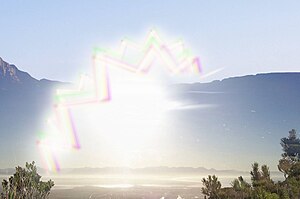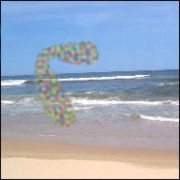Aura (symptom)
| Aura | |
|---|---|
 | |
| Artist's depiction of zig-zag lines appearing as part of a migraine aura phenomenon | |
| Specialty | Neurology, Neuro-ophthalmology |
| Types | Scintillating scotoma |
| Differential diagnosis | Persistent aura without infarction, retinal migraine, visual snow |
An aura is a perceptual disturbance experienced by some with epilepsy or migraine. An epileptic aura is a seizure.[1]
Epileptic and migraine auras are due to the involvement of specific areas of the brain, which are those that determine the symptoms of the aura. Therefore, if the visual area is affected, the aura will consist of visual symptoms, while if a sensory one, then sensory symptoms will occur.
Epileptic auras are subjective sensory or psychic phenomena due to a focal seizure, i.e. a seizure that originates from that area of the brain responsible for the function which then expresses itself with the symptoms of the aura. It is important because it makes it clear where the alteration causing the seizure is located. An epileptic aura is in most cases followed by other manifestations of a seizure, for example a convulsion, since the epileptic discharge spreads to other parts of the brain. Rarely it remains isolated. Auras, when they occur, allow some people who have epilepsy time to prevent injury to themselves and/or others when they lose consciousness.
The aura of migraine is visual in the vast majority of cases, because dysfunction starts from the visual cortex. The aura is usually followed, after a time varying from minutes to an hour, by the migraine headache. However, the migraine aura can manifest itself in isolation, that is, without being followed by headache. The aura can stay with a migraine sufferer for the duration of the migraine; depending on the type of aura, it can leave the person disoriented and confused. It is common for migraine sufferers to experience more than one type of aura during the migraine. Most people who have auras have the same type of aura every time.
Auras can also be confused with sudden onset of panic, panic attacks or anxiety attacks, which creates difficulties in diagnosis. The differential diagnosis of patients who experience symptoms of paresthesias, derealization, dizziness, chest pain, tremors, and palpitations can be quite challenging.[2]
Seizures[]
An epileptic aura is the consequence of the activation of functional cortex by abnormal neuronal discharge.[3] In addition to being a warning sign for an impending seizure, the nature of an aura can give insight into the localization and lateralization of the seizure or migraine.[citation needed]
The most common auras include motor, somatosensory, visual, and auditory symptoms.[4] The activation in the brain during an aura can spread through multiple regions continuously or discontinuously, on the same side or to both sides.[5]
Auras are particularly common in focal seizures. If the motor cortex is involved in the overstimulation of neurons, motor auras can result. Likewise, somatosensory auras (such as tingling, numbness, and pain) can result if the somatosensory cortex is involved. When the primary somatosensory cortex is activated, more discrete parts on the opposite side of the body and the secondary somatosensory areas result in symptoms ipsilateral to the seizure focus.[citation needed]
Visual auras can be simple or complex. Simple visual symptoms can include static, flashing, or moving lights/shapes/colors caused mostly by abnormal activity in the primary visual cortex. Complex visual auras can include people, scenes, and objects which results from stimulation of the temporo-occipital junction and is lateralized to one hemifield. Auditory auras can also be simple (ringing, buzzing) or complex (voices, music). Simple symptoms can occur from activation in the primary auditory cortex and complex symptoms from the temporo-occipital cortex at the location of the auditory association areas.[6]
Examples[]



An aura sensation can include one or a combination of the following:
Visual changes[]
This section needs additional citations for verification. (June 2020) |
- Bright lights and blobs[7]
- Zigzag lines[8]
- Distortions in the size or shape of objects[9]
- Vibrating visual field[9]
- Scintillating scotoma[10]
- Shimmering, pulsating patches, often curved
- Tunnel vision
- Scotoma
- Blind or dark spots
- Curtainlike effect over one eye
- Slowly spreading spots
- Kaleidoscope effects[11]
- Temporary blindness in one or both eyes[12][13]
- Heightened sensitivity to light
Auditory changes[]
- Hearing voices or sounds that do not exist: true auditory hallucinations
- Modification of voices or sounds in the environment: buzzing, tremolo, amplitude modulation or other modulations
- Heightened sensitivity to hearing
Other sensations[]
This section needs additional citations for verification. (June 2020) |
- Strange smells (phantosmia) or tastes (gustatory hallucinations)[14]
- Heightened sensitivity to smell
- Synesthesia[15]
- Déjà vu or jamais vu
- Cephalic aura, a perception of movement of the head or inside the head
- Abdominal aura, such as an epigastric rising sensation
- Nausea[13]
- A sudden feeling of anxiety, fear, or foreboding
- Numbness or tingling (paresthesia)[13]
- Weakness on one side of the body (hemiparesis)[13]
- Feelings of being separated from or floating above one's body (dissociation)
- Sensation of limbs or teeth growing
- Feeling of overheating and sudden perspiration
- Inability to speak (aphasia) or slurred speech[14]
- Confusion; forgetting how to do common tasks or comprehend spoken words
See also[]
- Focal seizure – Epilepsy syndrome characterised by seizures preceded by isolated disturbances of a cerebral function
- Hallucination – Perception in the absence of external stimulation that has the qualities of real perception
- Persistent aura without infarction
- Synesthesia – Neurological condition involving the crossing of senses
- CADASIL
- Retinal migraine
- Photopsia – Presence of perceived flashes of light in one's field of vision
References[]
- ^ Epilepsy auras
- ^ Sudden Onset Panic: Epileptic Aura or Panic Disorder? Robin A. Hurley, M.D., Ronald Fisher, M.D., Ph.D. and Katherine H. Taber, Ph.D.
- ^ Perven G and So NK (2015). "Epileptic auras: phenomenologu and neurophysiology". Epileptic Disorders. 17 (4): 549–562.
- ^ Sharma S., Dixit V. (2013). "Epilepsy – A Comprehensive Review". International Journal of Pharmacological Research & Review. 2 (12): 61–80.
- ^ Tuxhorn I. E. B. (2005). "Somatosensory auras in focal epilepsy: A clinical, video EEG and MRI study". Seizure: European Journal of Epilepsy. 14 (4): 262–268. doi:10.1016/j.seizure.2005.02.005. PMID 15911361. S2CID 18386228.
- ^ Foldvary-Schaefer, N. & Unnwonqse, K. (2011). Localizing and Lateralizing features of auras and seizures. Epilepsy behavior 20: 160-166
- ^ "Aura: Migraine's Odd Companion". Migraineur. Retrieved 2021-03-17.
- ^ "Patient's Guide to Visual Migraine - Brigham and Women's Hospital". www.brighamandwomens.org. Retrieved 2021-03-17.
- ^ Jump up to: a b Vincent, MB; Hadjikhani, N (2007). "Migraine aura and related phenomena: beyond scotomata and scintillations". Cephalalgia. 27 (12): 1368–1377. doi:10.1111/j.1468-2982.2007.01388.x. ISSN 0333-1024. PMC 3761083. PMID 17944958.
- ^ "Understanding the Aura Stage of Migraine Doctor Q&A". Migraine Again. 2020-12-30. Retrieved 2021-03-17.
- ^ "What Causes Kaleidoscope Vision?". Greatist. 2020-01-29. Retrieved 2021-03-17.
- ^ Robert, Teri. "Living Well With Migraine Disease and Headaches" New York HarperCollins 2004
- ^ Jump up to: a b c d http://www.ccjm.org/content/72/6/529.full.pdf+html
- ^ Jump up to: a b Kissoon, Narayan R.; Cutrer, Fred Michael (July 2017). "Aura and Other Neurologic Dysfunction in or with Migraine". Headache. 57 (7): 1179–1194. doi:10.1111/head.13101. ISSN 1526-4610. PMID 28542895. S2CID 13042444.
- ^ Marcel Neckar; Petr Bob (11 January 2016). "Synesthetic associations and psychosensory symptoms of temporal epilepsy". Neuropsychiatric Disease and Treatment. 12: 109–12. doi:10.2147/NDT.S95464. PMC 4714732. PMID 26811683.
- ^ Page 258 in: Britt Talley Daniel (2010). Migraine. AuthorHouse. ISBN 978-1-4490-6962-9.
External links[]
| Classification |
|---|
- Medical terminology
- Symptoms and signs: Cognition, perception, emotional state and behaviour
- Hallucinations
- Epilepsy
- Migraine

